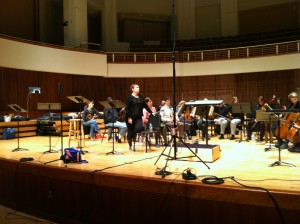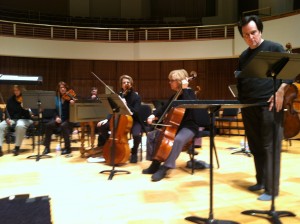Monday January 23, 2012
We all arrived at the Clarice Smith Performing Arts Center on the campus of the University of Maryland at 1 PM after a day off, our first in a week. We were all feeling good about our performance at the Kennedy Center and came to the recording session having spent a day visiting museums, shopping, spending time with family and friends, reconnecting with our lives, refreshed.
This large theater looks somewhat like an indoor football stadium or a mega church. The roof is so high, enclosing so much vertical space that it wouldn’t be surprising to see pigeons flying high above us, clouds under them. Opera Lafayette has recorded all its commercial CDs here because it is an ideal room and location for the work. It has the best acoustics for recording, comfortable back stage areas for the artists to rest, and café’s and restaurants nearby.

The process of recording is laborious, even harsh. There is always a fear that you just did not get it, did not get a “take” that presents the music in a living, exciting yet clean performance. Even though editing is a simple affair and a wrong note can be eliminated, an exciting performance cannot be conjured up by even the latest technology. “Letting go” or playing with spontaneous flair into a microphone isn’t natural. It may be similar to making love for a camera.
There are several power centers or deciding voices at a recording session and then there are all of us, the artists on their instruments producing the best they can, over and over.
Ryan Brown, the conductor, is responsible for shaping the performance. His technique must be the clearest possible and his ears hear so well as to make sure he has what he wants for the recording. He asks, “Are you sure we have the forte at measure 35?” or “were we really together at the cadence” and similar questions. He is ready to record it again. His inclination is to do it again 1000 times.
Nancy Snider, our orchestra manager, is the keeper of the clock. She notes how much time any one aria or chorus is using in the day and at a certain point we all here “let’s move this along,” or “can we just do this and stop talking,” or “we have 45 seconds to finish recording this allegro.” In so many ways, it is Nancy’s hard-nosed sheep herding that will assure we get our project completed. Her inclination is NOT to do it again and to have done with it in 2 takes.
 In the recording both, Barbara Wolf and Antonino d’Urzo are presiding over the recording machines and following the scores. They produce the recording and report to us after each take what is still blemished. “Ensemble at measure 116 (this means we weren’t playing exactly together), the “a” in the woodwinds is sharp at measure 237”, “Andrew, the harpsichord is coming in early at the cadence.” All of us–Ryan, the Orchestra and the singers–rely on Barbara’s ears to know what is achieved and what needs to be recorded again.
In the recording both, Barbara Wolf and Antonino d’Urzo are presiding over the recording machines and following the scores. They produce the recording and report to us after each take what is still blemished. “Ensemble at measure 116 (this means we weren’t playing exactly together), the “a” in the woodwinds is sharp at measure 237”, “Andrew, the harpsichord is coming in early at the cadence.” All of us–Ryan, the Orchestra and the singers–rely on Barbara’s ears to know what is achieved and what needs to be recorded again.
Finally there are the other singers who listen to each other’s arias for diction, French pronunciation, pitch and tone.
We all concentrate so very hard. There are times when we sense that everything is going along so well and then someone’s hand slips and makes an error that might well be a defeating blemish for the take, or the phrase. “Oh, I can’t believe I did that” is often thought or quietly admitted to a neighbor during these sessions.
I have never known anyone who enjoyed the process of recording. But as I listen to the takes, and I share them with you here, I’m very pleased and proud to be doing this first recording of Monsigny’s Le Roi et le fermier.




Enlightening comment on recording sessions. As a result, we, the listeners, can enjoy the artistry of their performance without being distracted by obvious blemishes.